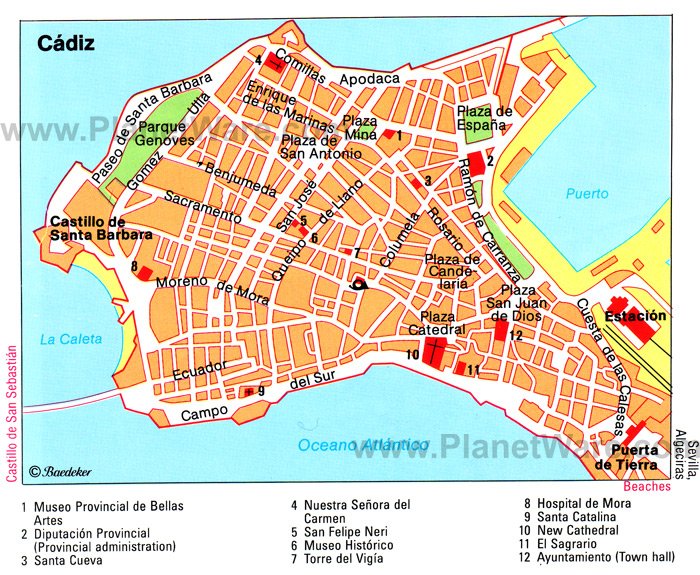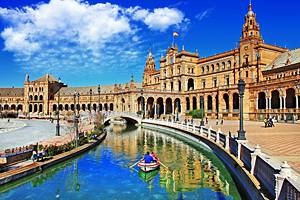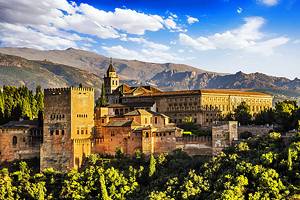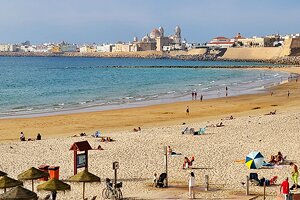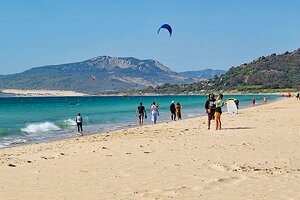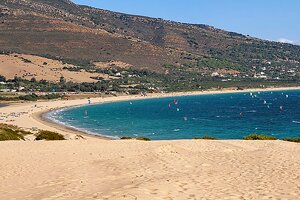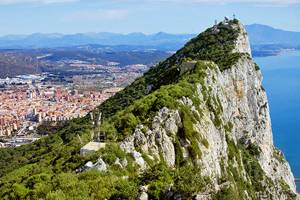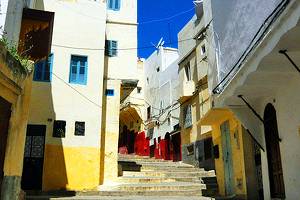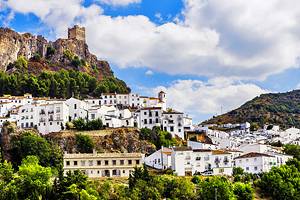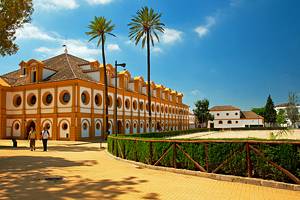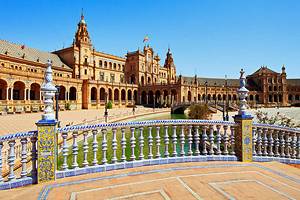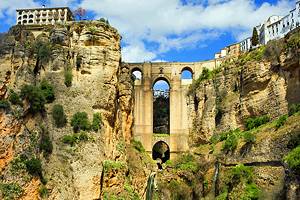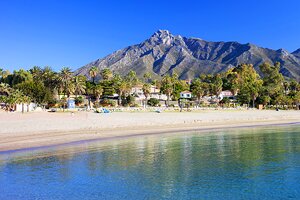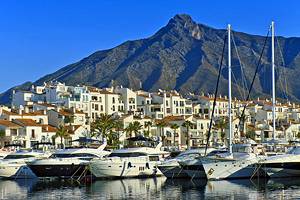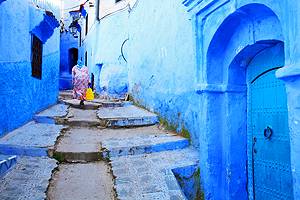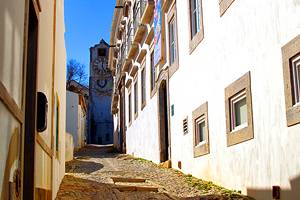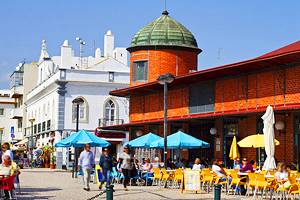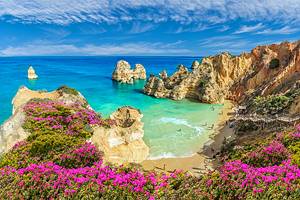Things to Do in Cádiz
Authors Lana and Michael Law visited Cadiz as part of a 10-week trip through southern Spain.
Cádiz is an elegant seaport surrounded by endless beaches along the sunny Costa de la Luz. Although most tourists come here to enjoy the sun and sand, the city has plenty of things to do, from the palm-lined promenades to plazas filled with huge banyan and fragrant orange trees.
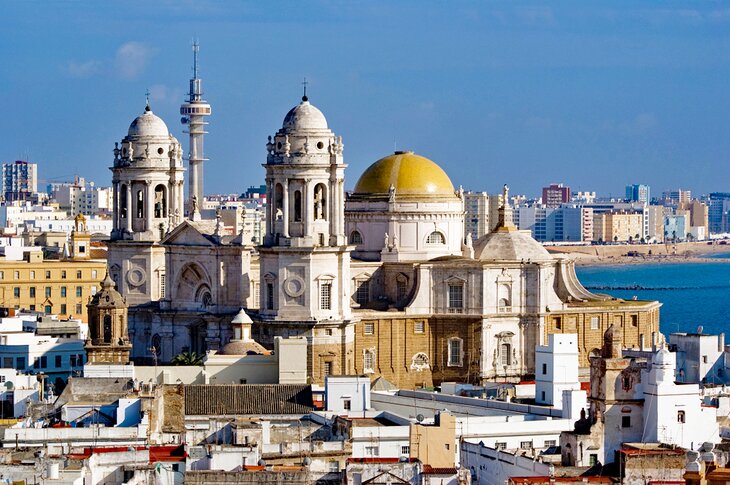
Cádiz is the oldest city in Europe (settled around 1100 BCE), and many of the city's attractions focus on the history. It was also the launching point for the travels of Christopher Columbus to the New World.
Las Puertas de Tierra (the city gates) guard the ancient center of Cádiz, an enchanting jumble of distinct barrios such as La Viña, the historic fisherman's neighborhood; the atmospheric medieval Barrio del Pópulo; and the gypsy quarter of Santa María, birthplace of the flamenco song.
Learn about the best places to visit in this sun-drenched coastal city with our list of things to do in Cádiz.
- Wander the Seafront Promenades & Gardens
- Relax on the Beaches in Cádiz
- Catedral Nueva (New Cathedral)
- El Pópulo: The Oldest Barrio of Cádiz
- Plaza de San Juan de Dios
- See the View from Torre Tavira
- Museo de Cádiz
- Oratorio de San Felipe Neri
- Museo de las Cortes de Cádiz
- Hospital de Mujeres and Capilla de Nuestra Señora del Carmen
- Fiestas de Carnaval
- Day Trip to Sanlúcar de Barrameda
- Day Trip to the Beach Resort of Chipiona
- Exploring Cape Trafalgar's Spectacular Coastline
- Day Trip to Playa de la Bolonia
- Exotic Excursions
- Spanish City of Ceuta in Africa
- Monte Hacho
- Melilla: Spanish Province on the Moroccan Coast
- Map of Things to Do in Cádiz
Wander the Seafront Promenades & Gardens
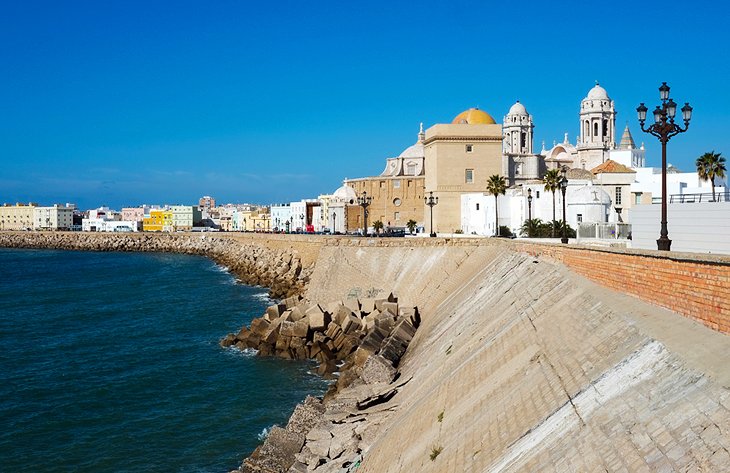
The palm-fringed seafront promenades, north of the Plaza de España, are a pleasant place to visit for a leisurely stroll. The picturesque Alameda de Apodaca is a wide, terraced promenade lined with leafy palms and old-fashioned street lamps. This broad pathway is a favorite place for locals to enjoy their paseo por la noche (evening strolls).
From the Alameda Marqués de Comillas promenade, you can admire the monument to Marquis of Comillas and the bayside scenery. Both of these promenades are flanked by waterfront gardens filled with shady trees and well-manicured shrubbery.
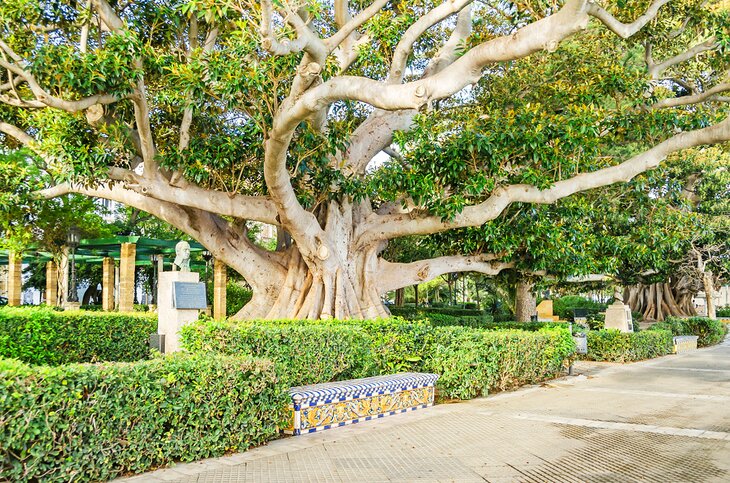
The seaside Parque Genovés is a meticulously landscaped green space filled with exotic trees, including a variety of palm trees, and tropical flowers. The park also has a charming footbridge alongside gently cascading waterfalls. After exploring the gardens, you can stop for refreshments at the park's café.
The seaside walkway extends nearly six kilometers to the south and runs past many of the best beaches in Cadiz. Although the architecture of the buildings inland, mostly condos from the 1960s and 1970s, is less than aesthetically appealing, the vibe of the walkway and the non-stop views out to the Atlantic can't be beat.
Relax on the Beaches in Cádiz
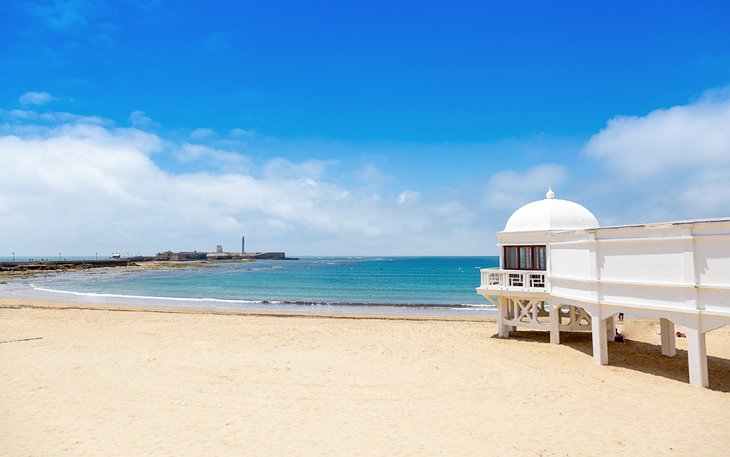
Beautiful beaches and a warm Mediterranean climate make Cádiz a favorite seaside destination.
Within the Old Town of Cádiz, a popular beach on the Bay of La Caleta is the Playa de la Caleta. This Blue Flag beach has a wide shoreline of golden sand and calm waters, safe for swimming and wading. The beach also has good facilities and lifeguard surveillance. The area around the Playa de la Caleta is full of restaurants and snack bars. The beach is best enjoyed at high tide.

Beyond the historic center is the Playa de Santa María del Mar, a long stretch of fine sandy shores in a more urbanized environment. The oceanfront promenade behind the beach is a scenic place for a leisurely stroll, with views out to sea and to the Old Town.
A continuation of Playa de Santa María del Mar is another wonderful beach, the Playa de la Victoria, one of the best beaches in Spain. This expansive sandy beach has a pleasant promenade, the Paseo Maritimo, and excellent public facilities, including changing rooms and showers.
The city's longest beach is the Playa de Cortadura. It's well equipped with public facilities and a few restaurants.
Farther along from Playa de Cortadura is the completely natural Playa de Camposoto. This beach has no commercial facilities; it's just sand, ocean, wind, and dunes. It's a great place for shore fishing and solitude. A beach walk here is a delightful way to get back to nature. The only things you'll see are the ocean and dunes; a few shorebirds might keep you company as well.
Parking is easy here, and a boardwalk is located back from the dunes suitable for jogging, walking, and biking.
Catedral Nueva (New Cathedral)
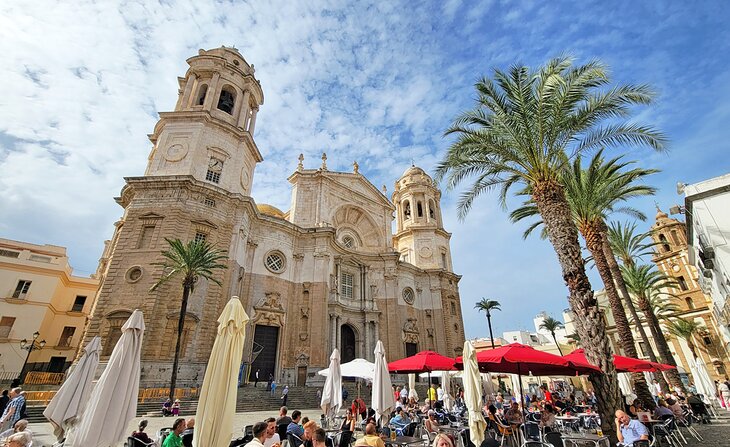
The Catedral Nueva stands on the bustling Plaza de la Catedral in the historic El Pópulo barrio of Cádiz. You can see the cathedral and then set up at a table under an umbrella to enjoy a meal, as well as the scene.
Visiting the Cathedral: You can visit the cathedral any day to see the cathedral's interior, an awe-inspiring space of grandiose proportions, 85 meters long by 60 meters wide, with massive pillars and exquisite 18th-century choir stalls. The visit allows access to the Torre de Poniente (tower), which affords sweeping views of the city and coastline. The cathedral holds Mass at 9:30am on Saturdays and at noon on Sundays.
The Cathedral: Exemplifying Spanish Baroque and Neoclassical styles of the 18th century, the cathedral was designed by Vicente de Acero in 1722 and completed in 1838. The impressive facade overlooking the Plaza de Pio XII is distinguished by its Baroque towers. A magnificent gilded dome glitters in the sunlight and is the most iconic feature of the Cádiz skyline.
The majestic dome reaches 52 meters in height and is adorned with classical patterns reminiscent of Rome's Pantheon. Light floods through the dome's windows, giving the sanctuary an ethereal ambience. Tombs of several bishops and the composer Manuel de Falla, a native of Cádiz, are housed in the crypt.
The Treasury houses the Cathedral Museum with an exceptional collection of religious art. One of the highlights is the Custodia del Millón, a four-meter-tall silver monstrance set with a million precious gemstones. The collection also includes exceptional art works, most notably the paintings by Alonso Cano and Murillo.
Address: Plaza de la Catedral, Cádiz
El Pópulo: The Oldest Barrio of Cádiz
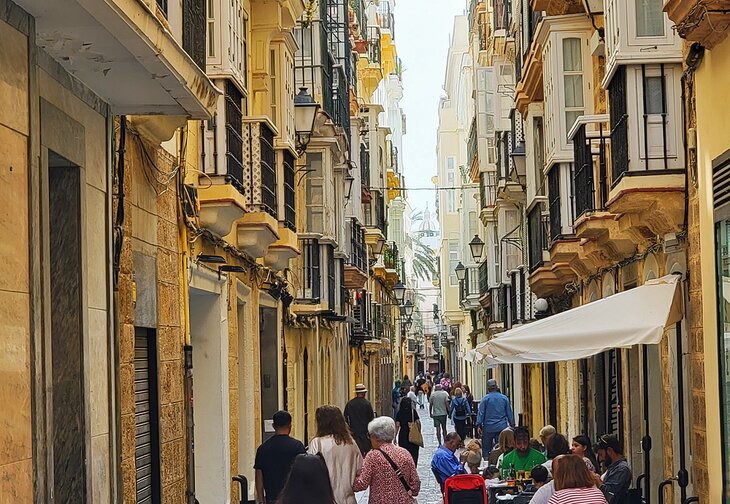
Enjoy a stroll back in time while exploring the oldest barrio in Cádiz. El Pópulo was originally settled in ancient Roman times and has ruins of the 1st-century BC Roman Theater (near the cathedral). Cobblestone streets, narrow alleys, and impressive palaces are the main attractions.
El Pópulo has retained the old gates that allowed entry to the medieval city; the Arcos de los Blancos is the entrance built by King Alfonso X in the 13th century.
Key Sights: A must-see sight is the Oratorio de la Santa Cueva (on Calle Rosario) built in 1783. Considered a gem of Neoclassical architecture, the church has two chapels and is decorated with noteworthy works of art, including masterpieces of painting by Goya. Oratorio de la Santa Cueva is open Tuesday through Sunday (admission fee).
From the Baroque period, the 17th-century Casa del Almirante (Admiral's House) is a palace with a monumental front gate and an elaborate facade of Italian marble.
Plazas: El Pópulo is also distinguished by its historic plazas. The Plazuela de San Martin is at the heart of the El Pópulo district. Just outside the El Pópulo district is another atmospheric square, the Plaza Topete. Also called the Plaza de las Flores, this spacious square hosts a colorful flower market.
Plaza de San Juan de Dios
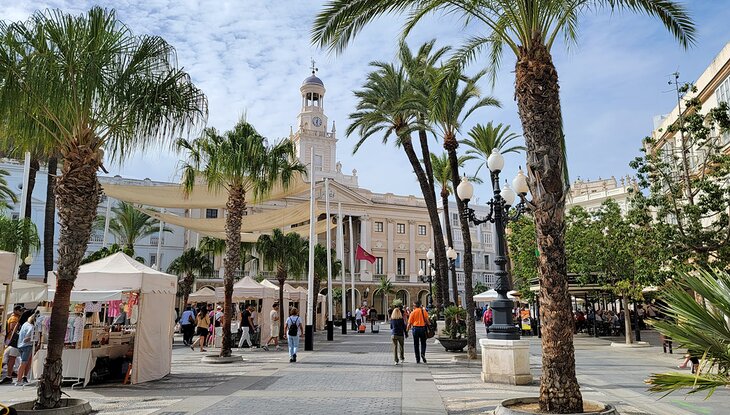
The wide-open space of Plaza de San Juan de Dios is a popular gathering spot for both locals and visitors alike. A large marble fountain located halfway up the square attracts musicians and other street performers. Nearby are stalls selling local crafts and clothing.
Farther up the plaza is the emblematic city hall with a clock tower that chimes to the melody of Cádiz composer Manuel de Falla's Amor Brujo. It's an imposing building that is set at a jaunty angle to the rest of the plaza.
The whole area is dotted with large palm trees, and along the edges of the plaza are restaurants with large covered patios, ideal places to settle in with a café con leche (coffee with milk) and practice your people-watching skills.
See the View from Torre Tavira
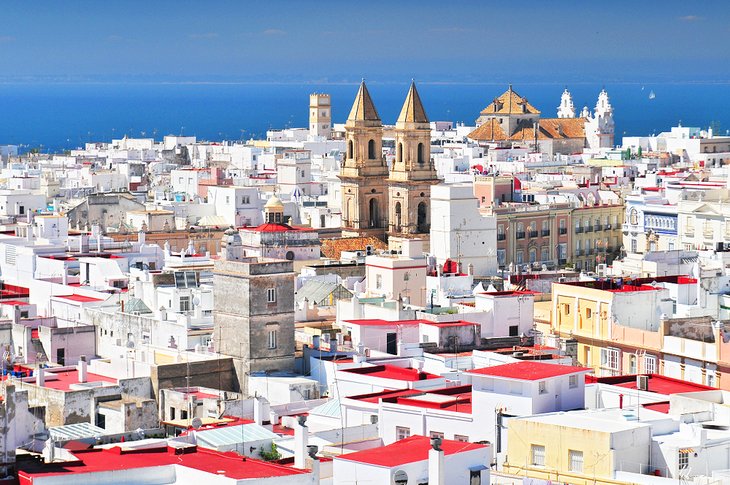
Cádiz is known for its watchtowers, testament to the city's trading importance in the 18th century. The town counts 129 watchtowers in total. In the center of Cádiz, the Torre Tavira is the highest point in the Old Town.
At 45 meters above sea level, the tower offers the best views along the coastline and far out to the horizon in the Atlantic Ocean. The Torre Tavira was used by Don Antonio Tavira to monitor the incoming ships traveling back with goods from America.
The Tavira Tower houses a museum dedicated to the history of Cádiz, with exhibits about trade in the 18th and 19th centuries, as well as a panel about the Spanish Constitution (La Pepa). The city takes pride that La Pepa was established here in 1812.
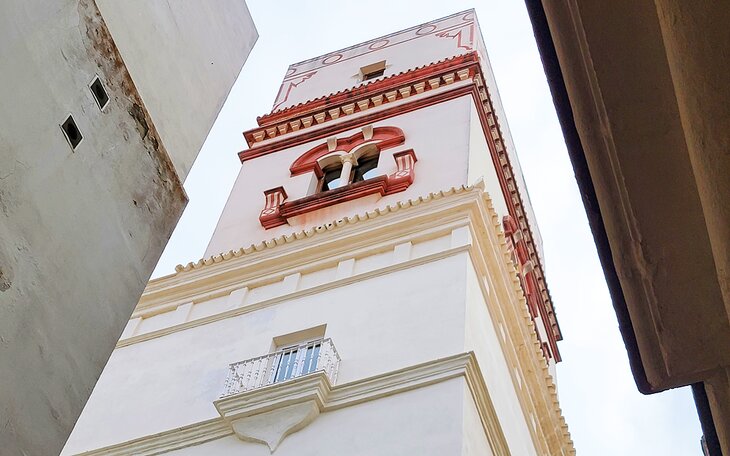
While visiting the Torre Tavira, you can use the Camera Obscura, which affords 360-degre panoramic views of the city's monuments.
Address: 10 Calle Marqués del Real Tesoro, Cádiz
Museo de Cádiz
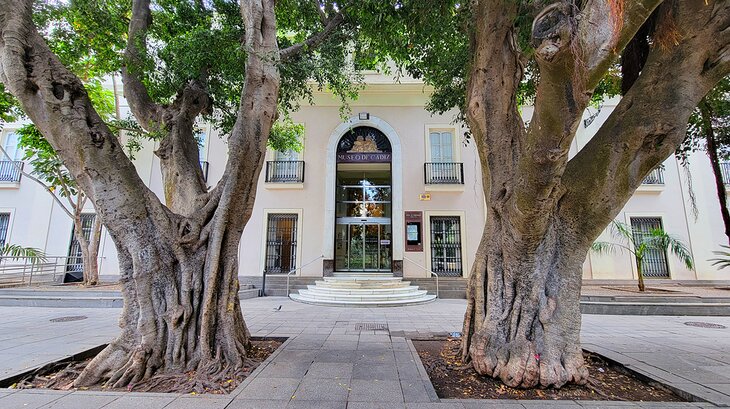
The Museum of Cádiz is renowned for its collection of ancient artifacts and fine arts. On the ground floor, the archeological section displays items discovered at a Phoenician necropolis site in Cádiz.
The most famous item of the archaeology collection is the Phoenician marble sarcophagus of the fifth century BC. Other Greek, Roman, Visigothic, and Arab antiquities round out the collection.
The museum's fine arts collection displays paintings by Zurbarán, including the Ecstasy of St. Bruno, the Vision of St. Francis of Assisi, and Pentecost. The collection also features Rubens' Holy Family and the works of Murillo (Ecstasy of St. Francis and Ecce Homo), Zurbarán, Ribera, Alonso Cano, van Eyck, and Rogier van der Weyden.
The top floor of the museum exhibits the traditional puppets used by the Tia Norica puppet company, which has been entertaining children in Cádiz since the mid-18th century. The company's puppet theater performances are lighthearted comedy sketches featuring adorable puppet characters.
The museum is open year-round Tuesday through Saturday from 9am until 9pm and on Sundays from 9am until 3pm (holidays from 9am until 3pm).
Out front of the museum is the Plaza de Mina, a very pleasant space with huge banyan trees and restaurants with delightful patios. Favored by locals, the restaurants and the plaza in general, are off the tourist track, with great cuisine and lower prices.
Address: Plaza de Mina, Cádiz
Oratorio de San Felipe Neri
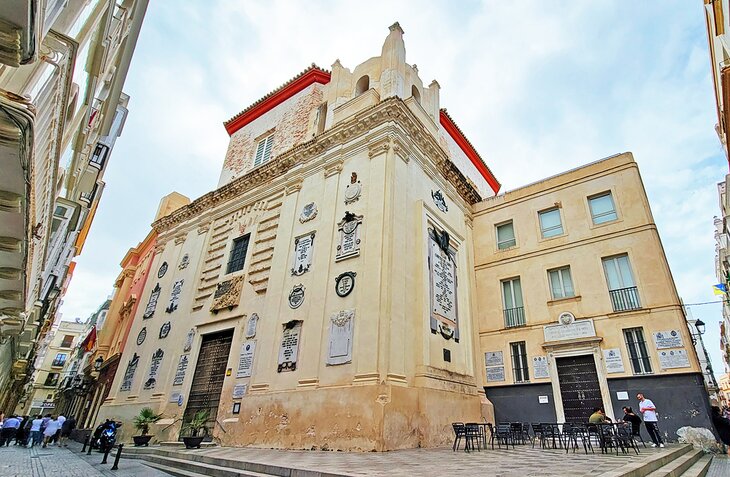
Built around 1688, this lovely little church is dedicated to Saint Felipe Neri. The Court of Cádiz met here in 1812 and produced the Spanish Constitution. A commemorative plaque noting this event graces the west side of the church.
The ornate barrel-vaulted interior features a gilded 18th-century Rococo-style main altar, above which is the remarkable painting of the Immaculate Conception by Bartolomé Esteban Murillo, the famous painter from Seville.
The Oratorio de San Felipe Neri is open to the public for visits Monday through Friday from 9am until 3pm. An admission fee is required for entrance, except to attend religious services on Sundays. The church holds a Mass in Latin every Sunday at 12pm.
Address: Calle Santa Inés, Cádiz
Museo de las Cortes de Cádiz
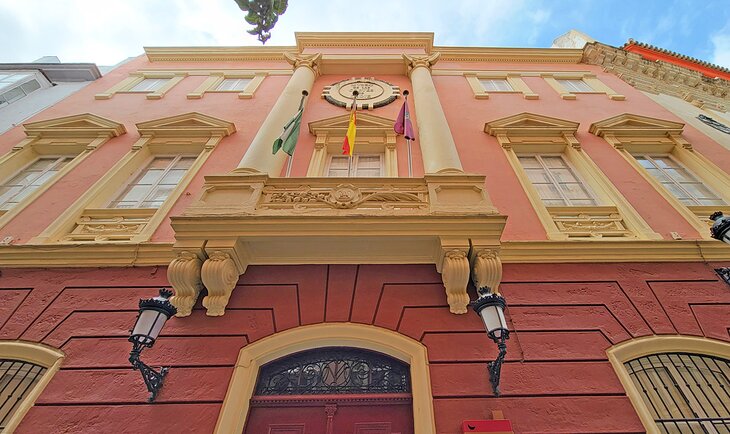
This Museum of the Cádiz Constitution was inaugurated in 1912 to commemorate the centenary of the Cádiz Constitution. The museum is next door to the Oratorio de San Felipe in a building where the court came together to work on the document.
You will gain a thorough insight into the Cádiz parliament of 1812 and the process that went into creating the Spanish constitution.
The museum is open Monday through Friday from 9am until 3pm; admission is free of charge.
Address: 9 Calle Santa Inés, Cádiz
Hospital de Mujeres and Capilla de Nuestra Señora del Carmen
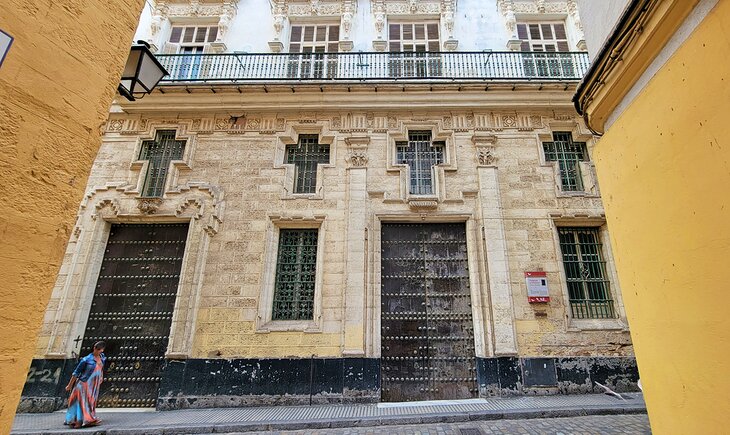
The 18th-century Hospital de Mujeres (Women's Hospital) is a gorgeous Baroque building organized around two courtyards with a grand staircase. The façade has three sections and is decorated with Italianate Baroque details.
The main tourist attraction of the building is the Capilla de Nuestra Señora del Carmen (Chapel of Our Lady of Carmen), which displays a Neoclassical altarpiece of the Virgin of Carmen and the renowned painting of Ecstasy of Saint Francis by El Greco.
The Women's Hospital building and chapel are open to the public for visits Monday through Friday from 9:30am until 1pm; the chapel requires an admission fee. Admission is free of charge from 8:30am until 9:30am on Mondays.
Address: 26 Calle Hospital de Mujeres, Cádiz
Fiestas de Carnaval
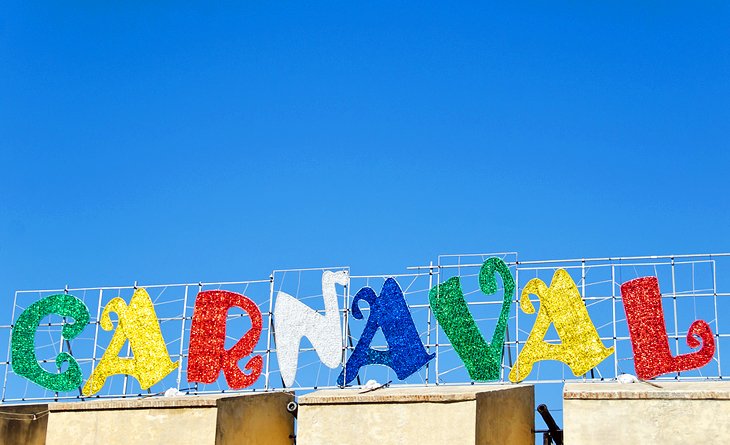
For a truly memorable experience, visit Cádiz during the joyous Fiestas de Carnaval. The festival begins on Shrove Tuesday, usually in February or early March, and lasts for 11 days.
The history of the Cádiz Carnival dates back centuries and was influenced by the legendary Carnival of Venice, one of Cádiz' old trading partners. During the lively festival, locals and tourists alike dress up in costumes and take part in celebrations on the street.
Much of the festivities takes place at the Plaza del Mentidero, while the parade spills out into the streets that are packed with revelers.
On the first Sunday of Carnival, thousands of merrymakers come out to watch the Gran Cabalgata (Carnival parade), which features a procession of classic floats (groups of people in costume with music). This colorful event exudes a sense of fun and gaiety.
On the last weekend, the Cabalgata del Humor (Comedy Parade) entertains crowds with silly humor, noisy music, and crazy costumes.
The Gran Teatro Falla hosts a competition a month before the start of Carnival, when more than 100 groups compete in different categories including Coros, traditional songs; Cuartetos, quartets; Chirigotas, satirical songs; and Comparsas, songs that parody the year's events. The Grand Finale of the competition, on the first Friday and Saturday of Carnival, is a highlight of the festivities.
Day Trip to Sanlúcar de Barrameda
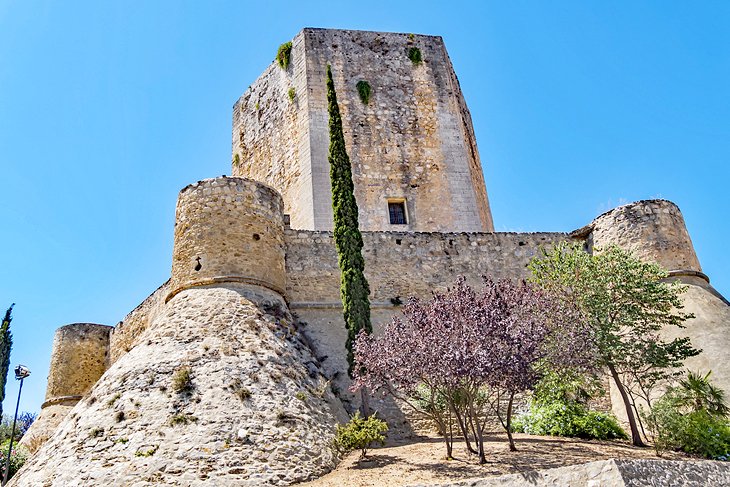
About 50 kilometers from Cádiz is the picturesque fishing town of Sanlúcar de Barrameda with a quaint historic center that has atmospheric, narrow, winding streets. Sanlúcar de Barrameda also boasts excellent seafood restaurants and a magnificent stretch of golden-sand beaches.
Extending for several kilometers, the four separate beaches of Sanlúcar de Barrameda include the Playa de Bonaza, a fine sand beach with calm waters; the Playa de La Calzada, which has a wide shoreline used for the Carreras de Caballos de Sanlúcar (horse races) in August; the Playa de Bajo de Guía, a busy beach with many restaurants and boat rentals; and the more rugged beach of Playa de La Jara, which draws many surfers, windsurfers, and para-gliders.
Day Trip to the Beach Resort of Chipiona

About 50 kilometers from Cádiz, the seaside resort area of Chipiona is a great choice for a relaxing holiday. The area offers many hotel options and several expansive beaches.
During summertime, the Chipiona beaches fill up with rows of lounge chairs and shady sun parasols. The beaches are well-maintained and feature excellent facilities (restaurants and public toilets), as well as lifeguard surveillance in the high season.
The attractive village of Chipiona has an old fishing port and a 16th-century church decorated with noteworthy works of art.
Exploring Cape Trafalgar's Spectacular Coastline
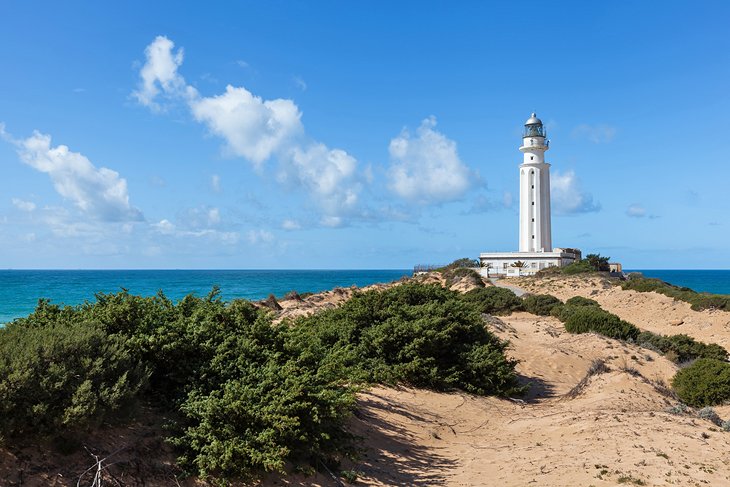
On the spectacular coast of Cape Trafalgar (58 kilometers from Cádiz), a top beach vacation destination is the quiet seaside community of Los Caños de Meca. The beaches of Los Caños de Meca feature excellent public facilities, water sports gear rentals, beachside restaurants, snack bars, and evening entertainment.
Things to do at Los Caños de Meca include swimming, windsurfing, surfboarding and scenic nature walks. Los Caños de Meca is found in the Parque Natural de la Breña y Marismas de Barbate, a protected area of pine forests, meadows, marshes, estuaries, and ocean bluffs.
Near Los Caños de Meca (1.5 kilometers away), you can reach the lovely Playa del Faro de Trafalgar by taking a pleasant (about 20-minute) seaside walk (or short drive).
Faro de Trafalgar Beach is prized for its pristine environment, golden-sand shoreline, and crystal-clear waters. However, note that Trafalgar Beach has strong ocean currents and powerful, turbulent waves that can be dangerous.
On the Playa del Faro de Trafalgar stands the Faro de Trafalgar (Trafalgar Lighthouse), built in 1862, which is a favorite spot to admire the marvelous ocean vistas and amazing sunsets.
Day Trip to Playa de la Bolonia
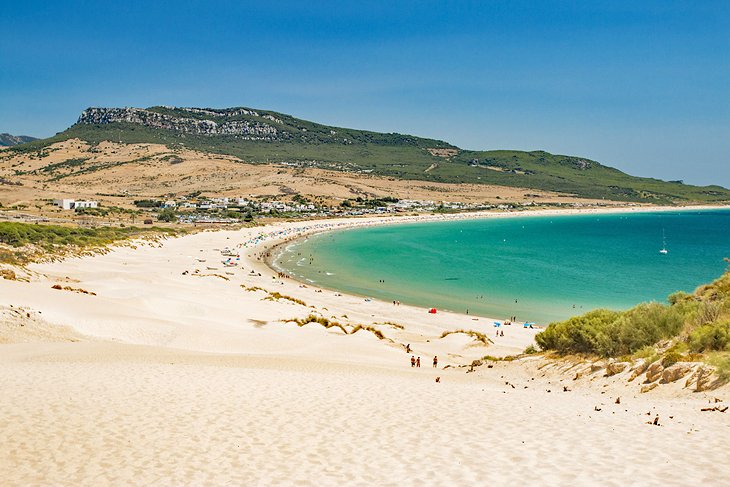
One of the prettiest Costa de la Luz beaches, the Playa de la Bolonia is further afield, about 95 kilometers from Cádiz and 15 kilometers northwest of Tarifa. Tucked away in an isolated nature reserve, this 3,800-meter-long, white-sand beach boasts stunning scenery.
A popular pastime when visiting here is to walk to the end of the beach and climb the dune located there. Photos taken back down the dune towards the intensely blue water are spectacular. If you are planning to do this excursion, be sure to drive down the road past the restaurants and over the bridge along the beach to the closest parking lot to the dunes. Be prepared for a bit of a workout, the dune is bigger than it appears!
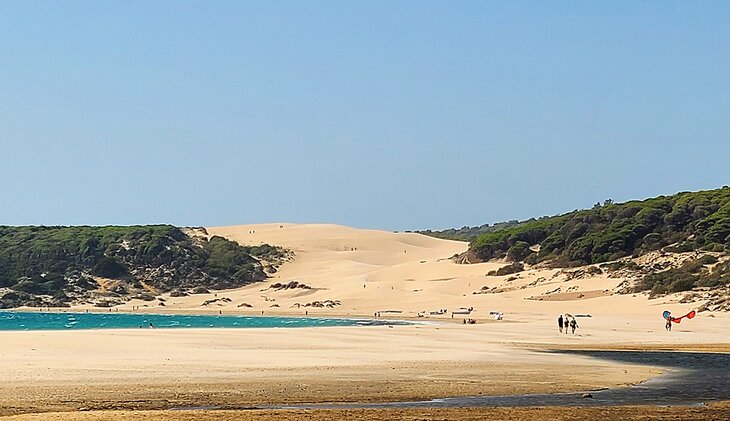
The Playa de la Bolonia also has ancient Roman ruins; the site was the Roman settlement of Belonia Claudia founded in 171 BC.
Bolonia Beach is also popular with windsurfers and kitesurfers because of the area's windy ocean air.
Exotic Excursions
Spanish City of Ceuta in Africa
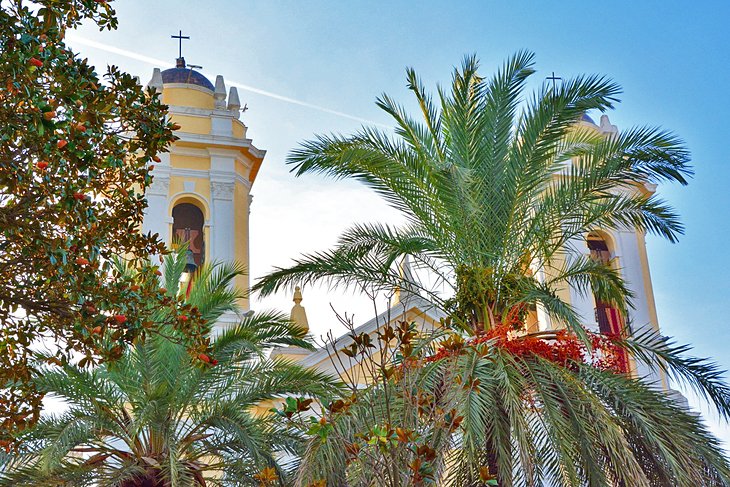
If setting foot on the African continent is on your list of things to do, then consider visiting Ceuta. This exotic destination is an autonomous Spanish city on a small piece of land in Morocco across from the Strait of Gibraltar. Although the city belongs to Spain, it has the ambience of Morocco and is a great starting point to explore other Moroccan tourist attractions.
To get here, travel about 90 kilometers from Cadiz to Algeciras, then take the one-hour ferry ride to Ceuta. This open-minded Mediterranean port city boasts a diverse mix of cultures. People of Christian, Muslim, Hindu, and Jewish faiths live together in harmony.
Must-see sights of Ceuta include the 18th-century Neoclassical cathedral built on the site of the town's Great Mosque and the Murallas Reales, ancient ramparts constructed in the 16th century to defend the town, complete with moats and a drawbridge.
Another highlight of Ceuta is the Parque Marítimo del Mediterráneo (Mediterranean Marine Park), an expansive park next to the marina that is filled with saltwater lakes, solariums, and gardens. The Marine Park also has a restaurant inside a castle-like building.
Another attraction of Ceuta is the coastline, which is ideal for kayaking, fishing, and scuba diving. Ceuta's coast offers a unique natural environment where the Atlantic Ocean and the Mediterranean Sea converge. Many sea creatures thrive here, including turtles, dolphins, and whales.
For an even quicker trip across the Strait of Gibraltar to Morocco, take the ferry ride from Tarifa to Tangier. The fishing port of Tarifa, 100 kilometers from Cadiz, is a one-hour ferry ride to Tangier in Morocco proper. Here, you can experience the enchanting atmosphere of Morocco, while getting lost in the winding old streets of the medieval medina. Ceuta is about 76 kilometers from Tangier.
Monte Hacho
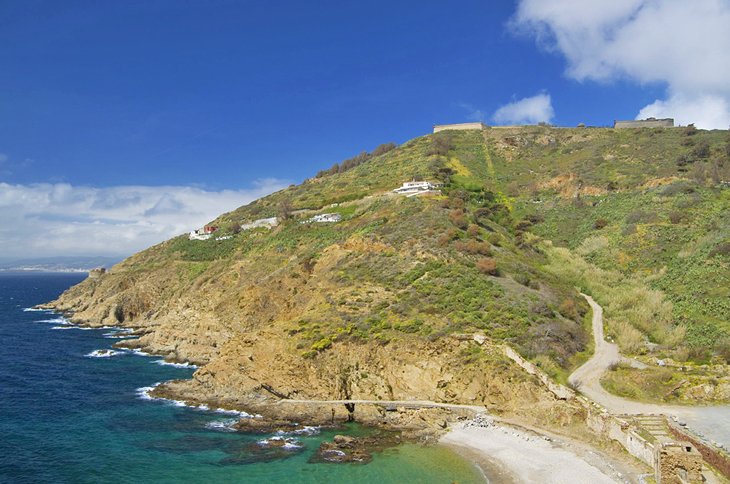
Monte Hacho is probably the legendary Mount Abyla in Greek and Roman mythology, one of the Pillars of Hercules that marked the end of the known world. An interesting trip from Ceuta, Monte Hacho is just four kilometers away, reached by the coastal road (Recinto Sur) that runs east along the south side of the peninsula.
The Recinto Sur route leads to the lighthouse on Punta Almina, which offers views of Gibraltar to the north and the Rif Mountains to the southeast.
At the summit of Monte Hacho, the 16th-century Ermita de San Antonio and an old fort preside over the landscape. From this vantage point at 194 meters, enjoy sweeping panoramas of the town, the harbor, and the Moroccan coastline. On a clear day, it's possible to see all the way to Gibraltar.
Melilla: Spanish Province on the Moroccan Coast
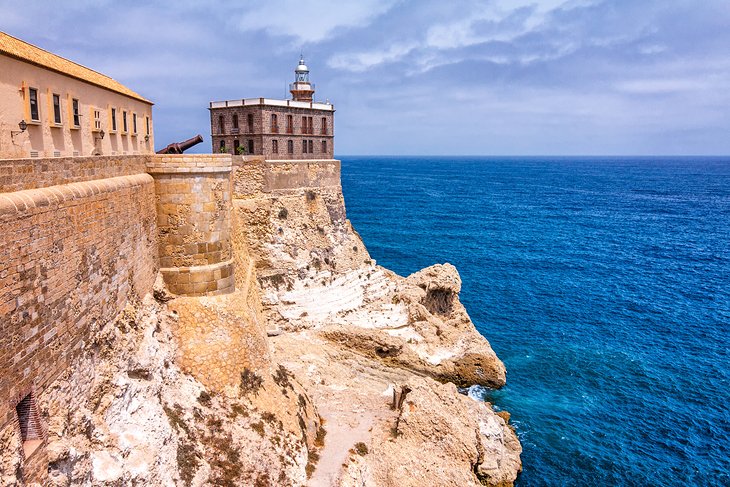
The farthest outpost of Spain along the Moroccan coast, Melilla is 380 kilometers from Ceuta. This ancient seaport, another autonomous Spanish city, has a well-preserved Ciudadela (Citadel), the historic fortified city perched on a hilltop overlooking serene turquoise waters. This fortress that encloses the Old Town is a superb example of military architecture of the 15th to 17th centuries.
The New Town has a Modernist flair. After Barcelona, Melilla is the second-most important city in Spain for its Art Déco and Modernist architecture, with around 900 buildings designed in avant-garde style.
Melilla is also popular with nature lovers, cyclists, and water sports enthusiasts. The nearby coastal area, with its marvelous underwater world, is wonderful for scuba diving.
Map of Things to Do in Cádiz
More Related Articles on PlanetWare.com

Highlights of Andalusia: Cádiz is a highlight of southern Spain's Andalusia region. Other must-see destinations include the elegant city of Seville (130 kilometers north of Cádiz), with its glorious cathedral and quintessential Andalusian character; and the charming town of Córdoba (250 kilometers from Cádiz) renowned for its UNESCO-listed 8th-century Great Mosque.
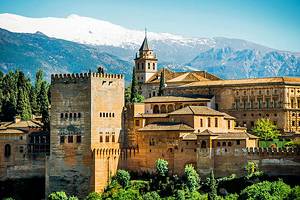
Moorish Castles and Whitewashed Villages: Granada (300 kilometers east of Cádiz) in the Sierra Nevada mountains was the last stronghold of the Moors, who built the majestic Alhambra palaces. To further discover the legacy of the Moors, travelers can explore the Pueblos Blancos (Whitewashed Villages) such as Jerez de la Frontera, just 35 kilometers from Cádiz, and the breathtaking cliffside town of Ronda (150 kilometers from Cádiz).
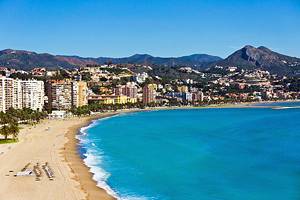
Sunny Seaside Vacation Spots: Cádiz is beautifully situated on the Gulf of Cádiz along the Atlantic Coast, near the Costa de la Luz, which boasts 300 days of sunshine a year. Along the neighboring Costa del Sol, the glamorous seaside resort of Marbella (200 kilometers from Cádiz) is the most upscale destination, while many popular beaches are found near Málaga, an urban seaport with fascinating historic monuments and fantastic art museums.

Exotic Excursions: Just 100 kilometers from Cádiz is Gibraltar, one of Britain's few remaining colonies. Gibraltar offers easy access by ferry to the evocative seaside city of Tangier on the northern coast of Morocco, where hidden cultural treasures, eye-catching landscapes, and a peaceful coastline await. Morocco also has fascinating cities, such as Marrakesh and Fes, with labyrinthine medieval quarters and colorful souks.
